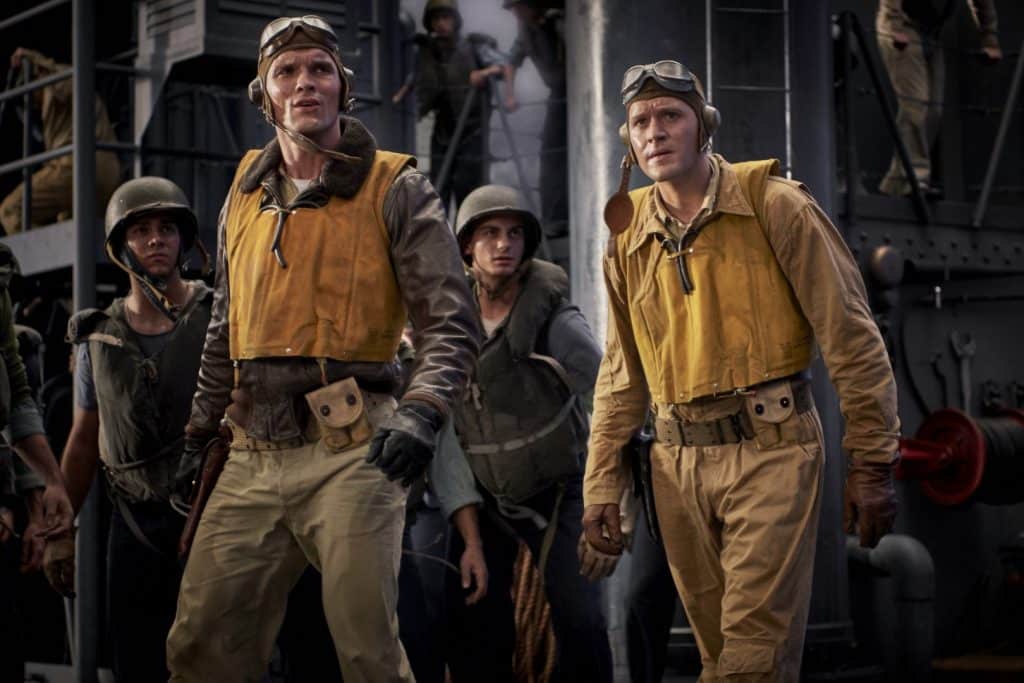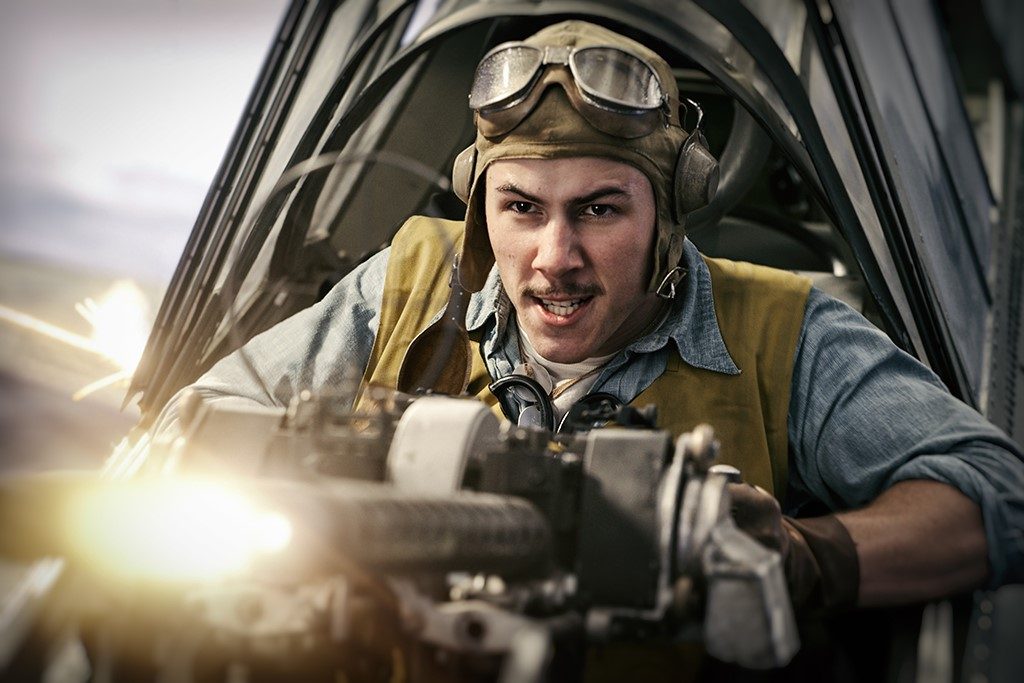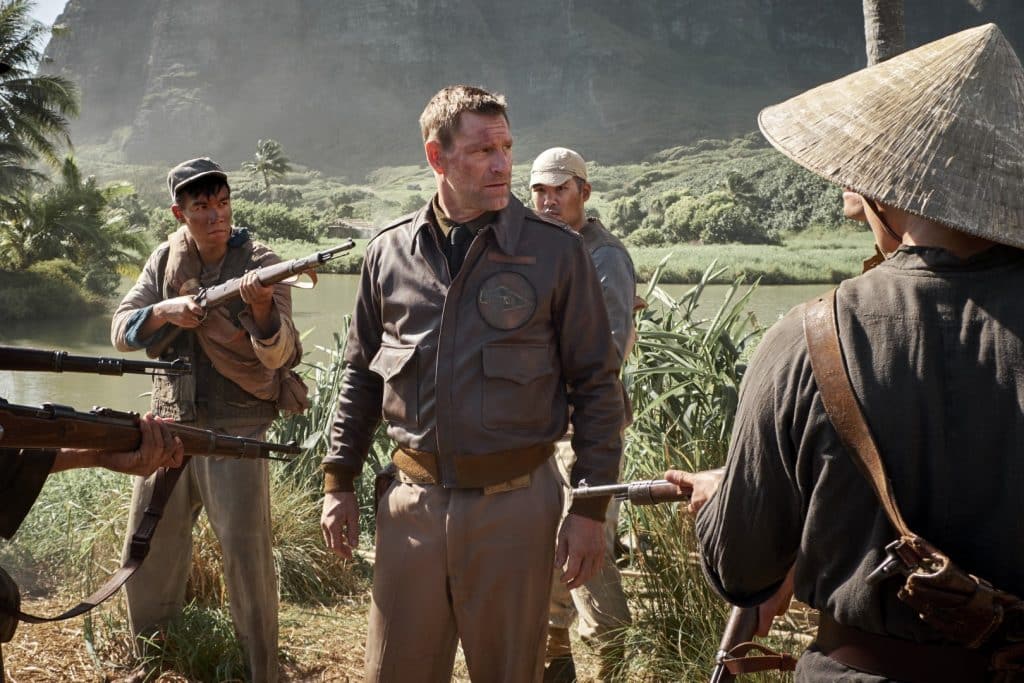Read also:
How to Watch FX Live Without CableHow To Watch AMC Without CableHow to Watch ABC Without CableHow to Watch Paramount Network Without CableWelcome back to More of a Comment, Really…, a weekly interview podcast hosted by Clint Worthington! Every episode will feature interviews with actors, filmmakers, producers, and more, giving you the skinny on the latest films and TV.
RSS | Apple Podcasts | Spotify | Stitcher
This Veteran’s Day sees the release of Midway, Roland Emmerich‘s action-packed recounting of the Pacific front in WWII, starting from the attack on Pearl Harbor and building to the titular offensive that turned the tide in America’s favor. We’re not short of films depicting the Greatest Generation, but Midway does its level best to offer up a snapshot of the many figures involved in one of WWII’s most pivotal battles. Central to the ensemble are Navy pilots and Pacific War heroes Richard “Dick” Best (Ed Skrein, Alita: Battle Angel, Maleficent: Mistress of Evil) and his best friend Clarence Earle Dickinson (Luke Kleintank, The Man in the High Castle, The Goldfinch), who evince the high-flying derring-do of Emmerich’s battle-hardened cast.
I sat down with Skrein and Kleintank to discuss the responsibility that comes with honoring the sacrifices of America’s Greatest Generation, the intense research that goes into playing such mythic real-life figures, and how much gum Skrein had to chew on set as his hotshot pilot.
(More of a Comment, Really… is a proud member of the Chicago Podcast Coop. Thanks to Backblaze for sponsoring this episode!)
How did both of you get involved in the project?
SKREIN: I was working on Maleficent [Mistress of Evil] at Pinewood, and I got an email saying Roland Emmerich wants to Skype with you. And when Roland Emmerich wants to Skype with you, you Skype with him back. So I Skyped with him, we shared the same enthusiasm and buzz for creativity and passion in cinema. They sent me the sides, and as I was on set with horns and four and a half hours’ worth of prosthetics, I would be sitting there in between [takes] with my Dick Best sides, learning my audition scenes with one of the other guys with horns, Anthony [Kaye].
And then one day afterward, I went into my trailer after a 17, 18 hour day, recorded the audition scene, and it felt great. Luckily, the sun was setting over the car park in Pinewood Studios, and it looked like Hawaii. It was amazing, so serendipitous. Luckily, I did a decent tape. I got the job, and I was so pleased.
KLEINTANK: My character’s Southern, so right before I Skyped [Emmerich], I was blasting country music. So I answered the phone, and he could hear the country music in the back, so I was like, [affecting a Southern drawl] “Want me to turn that down a li’l bit?” [laughs] He was like, “What are you listening to?” I said, “a little bit of country music.” He said, “I’m not a big fan of country music,” and I was like, “but my character is.”
So does Roland Emmerich really exist, or does he just exist over Skype?
SKREIN: I’m sure there are some characters who are more remote than others. He’s the opposite of that, he is all over everything. He’s a master of the micro, the macro, composition, the tiny things, the props. There is no one on set that doesn’t have him breathing down their neck, in a good way. He’s passionate, enthusiastic, he loves to be on set. He loves the work, he doesn’t get nervous or overwhelmed by everything that’s going on. It was a joy to watch Roland in his element, and I learned a lot from working with him.
Obviously, this is a film based on real events, you’re playing real people. What kind of research did you do to get into the minds of these heroes?
KLEINTANK: I watched as many documentaries as I could about that time, and read as many articles and looked at a lot of pictures. But the main thing for me is that my character [Dickinson] wrote a book called The Flying Guns, which he wrote six months after the [Battle of Midway]. He recounted everything he did in the story. There was no video footage of him, he was kind of a silent man as far as interviews and things like that. He wasn’t really in the public’s eye. But he did write a book, and that was everything for me.
SKREIN: Actually, Clarence Dickinson’s book was a huge help [for me, too]. Dick Best didn’t write a personal account, so [Dickinson’s] was incredibly informative. Dusty Kleiss wrote an incredible account called Never Call Me a Hero, though that was some years later. There were so many accounts of these men, and there were so many descriptions of Best from Dickinson and Kleiss that were very informative. There was so much information out there for us to pull on and look for.
Now, the attitudes of the men at this time, that’s where some of the challenges lay. Perhaps if we shot a movie about modern combat, we could learn about the nature of the terrain and the techniques, but we would understand where that generation was coming from – how they talk, what their cultural influences are, what their body languages and tics are. So we really had to research as much as we could and took the responsibility and the honor very, very, very seriously.
When doing work about the Greatest Generation, or however you’d like to call them, there’s a tendency to put them on a pedestal and mythologize them. What kind of work did you guys do to ground them and find their humanity and relate them to an audience?
KLEINTANK: Well, my character was the exact same age as me when I filmed it. I’m not a military man, but I think… yes, it was the Greatest Generation, it was a simpler time, men carried themselves a little differently — they carried themselves with honor, families and communities were a little more tightknit. But I think the servicemen we have today, same age, whether then or now, would have done the exact same thing these men did. If I was put in that situation, and I had the training, I would do it. I would rise to the occasion. Just because it’s all about what you’re fighting for.
Ed and I keep saying over and over, you don’t have to fight for the world, but you have to fight for the people that you love. They’re fighting for their wives, their children, and in turn that’s saving everyone else too.

Of course, a lot of that hinges on your characters’ friendship with one another. How did that reflect on your time filming together and building that relationship?
SKREIN: Oh, I hated him. [laughs]
Oh, should I leave so you guys can duke it out?
SKREIN: Yeah, we’ve got makeup on, because every time you guys leave, we thump each other. Those jokes sometimes don’t go down well in print [laughs]. But no, I think that Luke and I share… we’re from different continents, but we share a lot of morals and ideals and attitudes and worldviews. Attitudes toward creativity. I always describe him to my British friends, “he’s just like us, he’s the most British American you’ve ever met.” And I don’t even know what I mean by that, and I’m still not sure it’s a compliment. [laughs]
But we really connected from the first moment we met on Ford Island. I remember the first overriding memory of Luke was his passion for the project, and how seriously he took it. “Oh man, I’ve really met my match here.” That’s beautiful, that we’re gonna be able to go on this journey together, and I’ve got someone as committed as him next to me. You know, even when he was just speaking now, I was thinking “Man, if I went to war, I want Kleintank next to me.” Just like Dick wanted Dickinson next to him.
Which brings me to the air combat scenes, where you’re in a cockpit for most of it against a green screen. What were the challenges of trying to get yourselves in the groove of those scenes?
KLEINTANK: What you see in that movie is completely different from what we experienced [laughs]. It was like two different worlds. We were in a cockpit, yeah, we were in a kind of plane that they put on a gimbal. It moves side to side, up and down, and it’s all remote controlled. But it’s kind of funny, man, to be honest. You’ve got Roland Emmerich on a loudspeaker going, “Ze bullets are flying! Boom! Big bomb! Boom!” You just have to react to this, and Roland’s voice. You can’t help but want to laugh, but you have to stay in it.
But look, we were all super serious about it, so even Roland’s voice, maybe I laughed once in a while, but we were in it.
SKREIN: I think because the subject matter and the seriousness of representing these guys and this generation…
Did you feel a responsibility?
SKREIN: Of course! Of course, responsibility and honor and respect. That meant, as Luke says, if we were flying away from aliens and stuff, we would have laughed and messed around a bit more. Even with all the seriousness, I do always make sure to leave time to mess around a bit, within professional parameters. But we took it so seriously, man, and everyone seemed to take it seriously.
When I speak to Luke Evans, Patrick Wilson, they researched their characters in such depth. The whole cast, the writer Wes Tooke, the director, everyone was so committed. We’re talking about the art department, props, costumes, even hair and makeup. The research that went into this, and the focus on historical accuracy, was unprecedented in anything I’ve ever worked on. And I think that comes across on the screen.

I did find it interesting that the opening text doesn’t read, “based on a true story”, but “this is a true account.”
KLEINTANK: When you see some of the things in this film, like even Bruno Gaido jumping into the plane and shoots down a Japanese plane, that guy actually really did that. That’s true. Everything in this movie, everything you see that makes you go, “no, that looks like a Hollywood kind of thing.” It’s not, these guys actually did it.
At the same time, this movie does hearken back to the old war movies of Hollywood’s heyday — Tora! Tora Tora!, the 1976 Midway. Did you look back at some of those films to get an idea of how World War II looked in cinematic terms?
KLEINTANK: I personally didn’t. I wanted to have a new, fresh outlook on things. For me, it was mainly documentaries. I wanted to look at the real men of the war. So I looked at John Ford’s documentary [The Battle of Midway] a lot. And it’s brief, but you still get the idea of what these men did. And Netflix did a wonderful thing just recently with [WWII in HD Colour]. Because when you look at pictures, or see documentaries in black and white, it seems like a whole different world. When you see it in color? Wow, they’re just like me. They’re just like us.
And also, there’s the Peter Jackson WWI doc…
SKREIN: They Shall Not Grow Old, yeah. The dialogue in that is just unbelievable.
KLEINTANK: It’s interesting too, because we went to Ford Island, and we got to meet all the military guys. They’re so disciplined, they have so much respect. “Thank you, sir.” Shaking your hand. It feels like they’re the same now as they were then. It was a different time, of course, but the military is the military. Their form of discipline and everything they’ve done since WWI is the same, how they operate. Their tradition hasn’t changed.
On a lighter note, Ed, ballpark, how much gum did you have to chew as Dick Best?
SKREIN: [exasperated] Oh my fucking God, so much fucking gum. I remember on the first day, they were like, “we’ve got three different types of gum, choose one.” I said, “give me one with no sugar because I’m gonna chew a lot of gum in this movie.” I taste it once, I go, “oh, let’s go with this, that’s great, I won’t get tired of this.” [rolls eyes] Oh, my gosh. So much fucking gum is the answer.
Did it help your character, though?
SKREIN: I mean, I thought it was a lovely touch. The picture and the cockpit and the gum, it brought a lovely little nuance to the character.

There’s certainly a great deal of reverence for the military in this, and for veterans. What do you hope vets get out of seeing this?
SKREIN: So far, we’ve been interacting a lot with servicemen and women. Last night, we were with a veteran of Midway, a 101-year-old man who served on the Yorktown. We met the Montford Reserves, the first black Marines allowed in the military, who weren’t allowed to train with their white counterparts in 1942. They had to fight to fight, you know? These men were incredible. We were with John Aquilino–
KLEINTANK: Yeah, the admiral of the Fifth Fleet–
SKREIN: He’s obviously very high ranking, but we were with officers and Marines at Pearl Harbors. We screened it for the Department of Defense, and the Navy in Hawaii, and it’s so reaffirming to hear the support and the pride they feel we’ve told their story. Of course, this means so much to the Navy, it’s a very important story in the history of America. But this is a global story: this had repercussions worldwide, just like D-Day did and the Battle of the Bulge and all these famous battles that have been documented, rightly.
We just want them to appreciate the hard work and respect we feel towards the servicemen and women we portray in this movie. It means so much to us to hear the positive affirmation they’ve given us. I would’ve been afraid to show my face to them if we hadn’t done a good job.
KLEINTANK: You also want to get it right, too. Last night we had some of the Navy historians from the Pentagon come up to us and say, “you guys got it right.” Which is like, check.
SKREIN: Yeah, we’ve had a lot of positive affirmation from the Navy, so I kind of feel like – in the nicest possible way – regardless of how this movie does at the box office or thereafter, I’m satisfied. The responsibility, the duty we felt while we were shooting was to the Navy, predominantly — the servicemen and women, the surviving family members of the veterans of Midway and WWII. That’s a big relief, and that means so much to me. Some of the most prideful moments of my life have happened in the last couple of weeks, so that means so much, man.